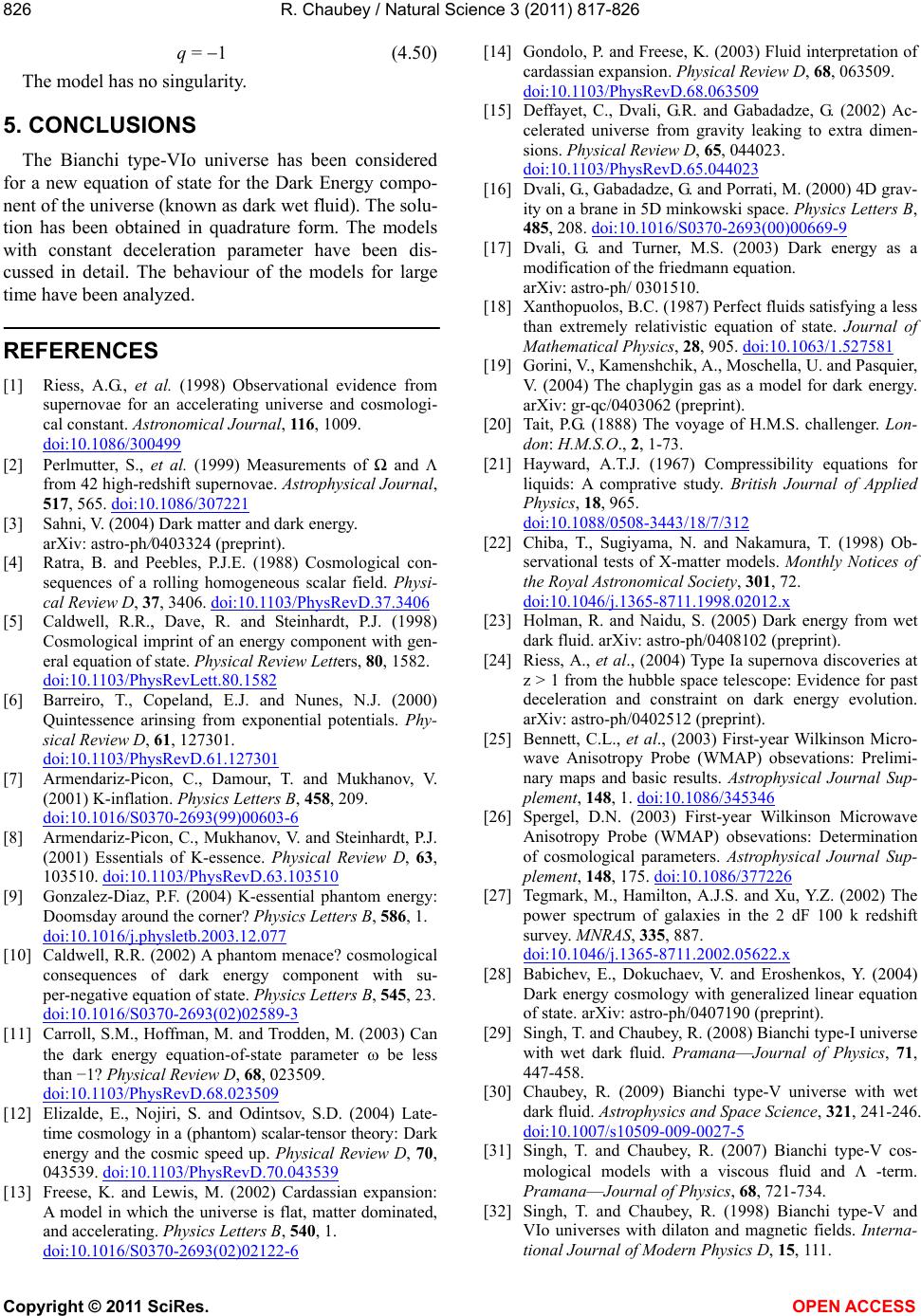
R. Chaubey / Natural Science 3 (2011) 817-826
Copyright © 2011 SciRes. OPEN ACCESS
826
=1q (4.50)
The model has no singularity.
5. CONCLUSIONS
The Bianchi type-VIo universe has been considered
for a new equation of state for the Dark Energy compo-
nent of the universe (known as dark wet fluid). The solu-
tion has been obtained in quadrature form. The models
with constant deceleration parameter have been dis-
cussed in detail. The behaviour of the models for large
time have been analyzed.
REFERENCES
[1] Riess, A.G., et al. (1998) Observational evidence from
supernovae for an accelerating universe and cosmologi-
cal constant. Astronomical Journal, 116, 1009.
doi:10.1086/300499
[2] Perlmutter, S., et al. (1999) Measurements of Ω and
from 42 high-redshift supernovae. Astrophysical Journal,
517, 565. doi:10.1086/307221
[3] Sahni, V. (2004) Dark matter and dark energy.
arXiv: astro-ph/0403324 (preprint).
[4] Ratra, B. and Peebles, P.J.E. (1988) Cosmological con-
sequences of a rolling homogeneous scalar field. Physi-
cal Review D, 37, 3406. doi:10.1103/PhysRevD.37.3406
[5] Caldwell, R.R., Dave, R. and Steinhardt, P.J. (1998)
Cosmological imprint of an energy component with gen-
eral equation of state. Physical Review Letters, 80, 1582.
doi:10.1103/PhysRevLett.80.1582
[6] Barreiro, T., Copeland, E.J. and Nunes, N.J. (2000)
Quintessence arinsing from exponential potentials. Phy-
sical Review D, 61, 127301.
doi:10.1103/PhysRevD.61.127301
[7] Armendariz-Picon, C., Damour, T. and Mukhanov, V.
(2001) K-inflation. Physics Letters B, 458, 209.
doi:10.1016/S0370-2693(99)00603-6
[8] Armendariz-Picon, C., Mukhanov, V. and Steinhardt, P.J.
(2001) Essentials of K-essence. Physical Review D, 63,
103510. doi:10.1103/PhysRevD.63.103510
[9] Gonzalez-Diaz, P.F. (2004) K-essential phantom energy:
Doomsday around the corner? Physics Letters B, 586, 1.
doi:10.1016/j.physletb.2003.12.077
[10] Caldwell, R.R. (2002) A phantom menace? cosmological
consequences of dark energy component with su-
per-negative equation of state. Physics Letters B, 545, 23.
doi:10.1016/S0370-2693(02)02589-3
[11] Carroll, S.M., Hoffman, M. and Trodden, M. (2003) Can
the dark energy equation-of-state parameter be less
than −1? Physical Review D, 68, 023509.
doi:10.1103/PhysRevD.68.023509
[12] Elizalde, E., Nojiri, S. and Odintsov, S.D. (2004) Late-
time cosmology in a (phantom) scalar-tensor theory: Dark
energy and the cosmic speed up. Physical Review D, 70,
043539. doi:10.1103/PhysRevD.70.043539
[13] Freese, K. and Lewis, M. (2002) Cardassian expansion:
A model in which the universe is flat, matter dominated,
and accelerating. Physics Letters B, 540, 1.
doi:10.1016/S0370-2693(02)02122-6
[14] Gondolo, P. and Freese, K. (2003) Fluid interpretation of
cardassian expansion. Physical Review D, 68, 063509.
doi:10.1103/PhysRevD.68.063509
[15] Deffayet, C., Dvali, G.R. and Gabadadze, G. (2002) Ac-
celerated universe from gravity leaking to extra dimen-
sions. Physical Review D, 65, 044023.
doi:10.1103/PhysRevD.65.044023
[16] Dvali, G., Gabadadze, G. and Porrati, M. (2000) 4D grav-
ity on a brane in 5D minkowski space. Physics Letters B,
485, 208. doi:10.1016/S0370-2693(00)00669-9
[17] Dvali, G. and Turner, M.S. (2003) Dark energy as a
modification of the friedmann equation.
arXiv: astro-ph/ 0301510.
[18] Xanthopuolos, B.C. (1987) Perfect fluids satisfying a less
than extremely relativistic equation of state. Journal of
Mathematical Physics, 28, 905. doi:10.1063/1.527581
[19] Gorini, V., Kamenshchik, A., Moschella, U. and Pasquier,
V. (2004) The chaplygin gas as a model for dark energy.
arXiv: gr-qc/0403062 (preprint).
[20] Tait, P.G. (1888) The voyage of H.M.S. challenger. Lon-
don: H.M.S.O., 2, 1-73.
[21] Hayward, A.T.J. (1967) Compressibility equations for
liquids: A comprative study. British Journal of Applied
Physics, 18, 965.
doi:10.1088/0508-3443/18/7/312
[22] Chiba, T., Sugiyama, N. and Nakamura, T. (1998) Ob-
servational tests of X-matter models. Monthly Notices of
the Royal Astronomical Society, 301, 72.
doi:10.1046/j.1365-8711.1998.02012.x
[23] Holman, R. and Naidu, S. (2005) Dark energy from wet
dark fluid. arXiv: astro-ph/0408102 (preprint).
[24] Riess, A., et al., (2004) Type Ia supernova discoveries at
z > 1 from the hubble space telescope: Evidence for past
deceleration and constraint on dark energy evolution.
arXiv: astro-ph/0402512 (preprint).
[25] Bennett, C.L., et al., (2003) First-year Wilkinson Micro-
wave Anisotropy Probe (WMAP) obsevations: Prelimi-
nary maps and basic results. Astrophysical Journal Sup-
plement, 148, 1. doi:10.1086/345346
[26] Spergel, D.N. (2003) First-year Wilkinson Microwave
Anisotropy Probe (WMAP) obsevations: Determination
of cosmological parameters. Astrophysical Journal Sup-
plement, 148, 175. doi:10.1086/377226
[27] Tegmark, M., Hamilton, A.J.S. and Xu, Y.Z. (2002) The
power spectrum of galaxies in the 2 dF 100 k redshift
survey. MNRAS, 335, 887.
doi:10.1046/j.1365-8711.2002.05622.x
[28] Babichev, E., Dokuchaev, V. and Eroshenkos, Y. (2004)
Dark energy cosmology with generalized linear equation
of state. arXiv: astro-ph/0407190 (preprint).
[29] Singh, T. and Chaubey, R. (2008) Bianchi type-I universe
with wet dark fluid. Pramana—Journal of Physics, 71,
447-458.
[30] Chaubey, R. (2009) Bianchi type-V universe with wet
dark fluid. Astrophysics and Space Science, 321, 241-246.
doi:10.1007/s10509-009-0027-5
[31] Singh, T. and Chaubey, R. (2007) Bianchi type-V cos-
mological models with a viscous fluid and -term.
Pramana—Journal of Physics, 68, 721-734.
[32] Singh, T. and Chaubey, R. (1998) Bianchi type-V and
VIo universes with dilaton and magnetic fields. Interna-
tional Journal of Modern Physics D, 15, 111.